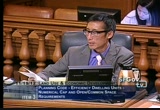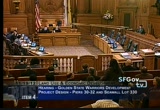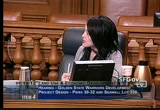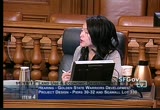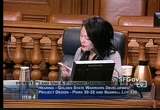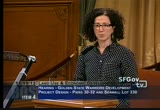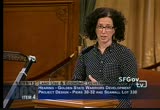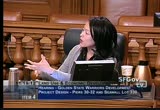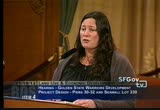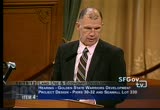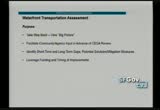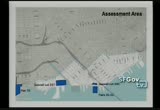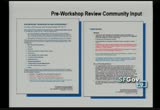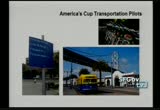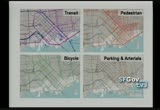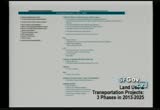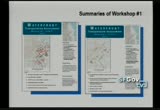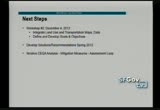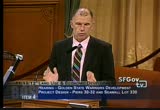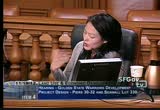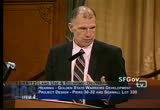tv [untitled] December 1, 2012 9:00am-9:30am PST
9:00 am
kim had comments. >> first i want to address one of the comments from public comment. i just want to state that the hotel referred to on sixth and howard is slated for affordable family housing and it's already in movement. i think there was some stalling because of the dissolution of redevelopment and that's part of the -- soma redevelopment area plan. but the funding has been secured for the hotel. what slowed it down is the building is historic. we have some additional processes unfortunately. but it will be fulfilling a need in the south of market which is the need for more family housing, multi-unit housing. of course, affordable housing for families which is great. but i do just want to say as someone who has a lot of concerns about efficiency units, particularly the impact in the south of market where we already have a lot of density, and also questioning the market need for this type of unit, i do appreciate the compromise that was brokered and i just want to thank supervisor wiener and all the advocates for really coming together and putting forward a solution where we can test out this type
9:01 am
of model of housing and see what the market demand is and kind of who inhabits this type of housing. i know it's a small amount, but i think it's a good start. so, i want to appreciate the work that went behind it. it was months and months of work. >> i want to just add also thanking supervisor wiener for working with the nine community-based organizations and affordable housing groups, also from planning and others that put a lot of work into this. i think there is a strong and firm safeguard that's really built into this compromise that allows flexibility in building more housing, but also is really sensitive looking at potential impacts and benefits of these types of smaller units. so, i'll be supportive. on the amendments, can we adopt the amendments without objection? thank you. and on the legislation itself as amended, as a committee report to the full board on november 30th, can we do that with positive recommendation without objection? thank you.
9:02 am
thank you. thank you, supervisor wiener. thank you, everyone. mr. evans, i forgot to mention we're being broadcasted by sfgtv and the hard working staff, jessie larson and jeff rob son. i'd like to thank them. mr. evans, could you please call item number 4? >> item number 4, hearing to consider the initial project design of the proposed golden gate -- golden state warriors development on piers 30 to 32 and seawall lot 330, and update on the waterfront transportation network assessment. >> thank you. and the sponsors are supervisor jane kim and president david chiu. so, we're joined by supervisor jane kim on this item. supervisor kim. >> thank you, chair mar. thank you for agendizing this hearing today. as many of you know, last wednesday at the budget finance committee, we considered the fiscal feasibility of the pier 30-32 project which includes a potential arena with our warriors team back here in san
9:03 am
francisco. the committee did determine that the project is fiscally feasible, but as many of you know, we do have a lot of concerns in the neighborhood as we move through this process. and, no, i called this hearing to readdress one of the current concerns that we've heard the most often regarding this project which is transportation. this hearing is the first of multiple hearings that i have requested to give the board periodic updates on the proposed golden gate warriors development project. this first hearing is just an informational hearing to consider the initial project design for the development on pier 30-32 with assessment of the transportation network very near and around pier 30-32. and i just also want to acknowledge today we do have [speaker not understood] the principal architect for this project. this hearing again gives us the opportunity to hear about one of the two top issues of concerns for constituents in the south beach rincon hill and mission bay neighborhood. the first that we occurred was
9:04 am
transportation. this area is already a neighborhood that is quite impacted by the regular traffic of workers and commuters onto the bay bridge as well as the 2 80. we have a lot of questions in terms of what this new arena -- what is really the assessed impact that we believe might occur and what types of investments do we as a city need to make to address the demands. we have some of the highest collisions between pedestrians and vehicleses in the south of market. so, how will this project impact those rates? second, we asked questions whether we can support bike infrastructure in that neighborhood to increase bike circulation so folks can bike to and [speaker not understood]. third, we have questions about what public transit investment costs are and to meet the demands of additional gains in this neighborhood. we've already seen what muni has been able to do with giants home games.
9:05 am
so, we have already some data analysis around what that might cost with additional warriors games. and i actually just want to bring up a point that one of my colleagues brought up last week at the budget committee meeting which i had not thought of, being that i don't represent outer portions of the city, but supervisor chiu brought up when we have giants home game night, muni doesn't run all the way to the sunset. i'm sure we experience that in other outer neighborhoods here in san francisco. the last issue of course that comes up often is the issue of parking and it's participants to games or other events circling around neighborhoods and turning the neighborhood into an overall parking lot. so, we're hoping to vet some of these issues today. just give some of the information the city already has. this is the first of many hearings, but i do think this will be a very important issue for us to address as this project moves forward in order for us to have a successful project. so, i do want to welcome folks that are here today.
9:06 am
we have jen matts who is the director of development on our southern waterfront. and i was hoping she could come up first and introduce the rest of the city family that will be presenting here today at land use committee. thank you, ms. matts. >> thank you very much, supervisor. i'm jennifer matts in the office of economic and work force development and i have the privilege of working on three major waterfront development projects currently for the city. we're really delighted to be here with you today and we have a pretty robust hearing and set of presentations. some of this information we've shared with both the cac and with the port commission, but this is the first time that we've come to you board of supervisors because these hearings are broadcast and televised, we think it will reach an even wider audience with a level of detail we haven't yet been able to communicate with the city at large. lisa pagan from our office will address issues and concerns that supervisor kim brought up.
9:07 am
peter all bert from the mta will be discussing the transportation survey and assessment that's currently ongoing for the waterfront and how that will impact the environmental review process for this project. we have byron the director of development from the port to discuss briefly the port's waterfront land use plan which we think provides very important context for why this location is appropriate to consider an arena. and then we will have craig talk about the actual design. it's really tremendous that we have craig here to present the design himself because really no one does it justice the way he does. after that we'll just have very brief comments from two other departments, san francisco fire department and the mayor's office of disability to talk about the ways in which both fire station and fire boats can hopefully be collated at this site. and also to talk about the outreach we've begun with the mayor's office of disability when we think about the 7 acres of open space in addition to the structures that are proposed for both the seawall
9:08 am
lot and piers 30-32. so, with that i would like to turn this over to lisa pagan. >> thanks. through the chair if i may, i did for get to bring up a second issue to bring up in the committee. i want to frame it with the perspective of the neighborhood. another concern is the quality of life issue which ms. pagan will be addressing. to give the public a sense of what we've been hearing, the concerns have been around additional crowds around the home game of the giants. there will be other nights we'll be experiencing the crowds and more trash in the neighborhood. urination is what we get complaints about, people leaving games and urinating on people's door steps. general crowd control and what that might look like if we had an arena and stadium in the neighborhood. thank you, ms. pagan, for being here. >> lisa pagan, office of economic and work force development.
9:09 am
thank you, supervisors, chair mar. i led a workshop on november 5th with at least 60 attendees where we talked about safety, noise, and other sort of quality of life impacts that people were concerned about related to the proposed development at piers 30-32, but also what the concerns are today, the existing conditions and also their concerns about future impacts of the proposed development. -- for the facility and multi-entertainment sports facility. so, it was a really great workshop in the sense that i got a lot of information. we split into five break out groups. we had surveys, written surveys. they talked with the facilitator in the break out group. they put stickers where they think that the impacts would happen. but they also provided a lot of verbal and we had a lot of notes, feedback. right now we're going through
9:10 am
all of that information and we're analyzing what are the main concerns, and what do people want to preserve about what they like about the neighborhood as it exists today. so, our hope is to finish analyzing the information and then we go back to the community and have some proposals how to address what they would like to see addressed. we stuck to cleanliness, safety, noise, because the transportation issues, peter all bert had a big workshop on the week before. so we didn't focus as much on public transportation and traffic, although we did touch on where traffic control might be located and needed. so, we're in the process. we haven't come up with the answers yet, but we are going to and work with the community on some strategies to address the concerns that you're talking about, cleanliness and
9:11 am
safety and impacts of different large events happening in the neighborhood. so, if you have any other questions, i'd be happy to answer, but [speaker not understood] finish analyzing the information about the [speaker not understood]. >> thank you. >> good afternoon, supervisors. peter all bert from mta. i'm going to talk about what we're doing with the waterfront transportation assessment. i'd like to actually -- first of all, i think it's really important for us in planning transportation to take that step back and do much more than just plan for one particular project. when so much is going on in the surrounding neighborhood, this idea of doing a transportation assessment was to get out ahead of what we know are three large projects that will be coming along pretty soon. we're working obviously with piers 30-32. we're aware of what is happening with mission rock. we'll be working with pier 70. it made sense for us at mta to
9:12 am
make sure that as a stakeholder ourselves in ensuring good transportation and looking at pedestrian and bicycle and transit and traffic and parking that we also are as concerned about the quality that comes out of this. what we see is an opportunity here and i appreciate the chance to work and get ahead of this opportunity. so, the slides that i have on the powerpoint, i don't know if that's coming across -- thank you -- one of the first steps we want to do is step back and look at not just pier 30-32, but look at the bigger waterfront area. that was brought at the fisherman's wharf pier 70. to make sure that as we rollup our sleeves and get in the transportation problem solving that we're working with the community most affected who live day to day with some of the issues, but the idea of community is pretty big. operating transit, it's residents who live near the traffic and transit issue. it's our partner agencies who deal with transportation if the employers and employee -- need to get back and forth to work.
9:13 am
it's obviously the clients that are hoping that their proposal are better and the quality of life in san francisco fits all of that. so, we also know that getting out ahead of the problem means getting out ahead of environmental review. it would be a real disadvantage for us at mta. if we were trying to come up with solutions to transportation problems while an e-i-r is thumping along at a quick pace, doing the assessment before the e-i-r has start today begin, there is a huge opportunity and i hope it becomes a role model for how we do big projects in the future. one of the things i'm open to do with this assessment is identify schorr term and long term gaps. there is a lot already going on. but is it going on in concert with the development proposals? * the transportation assessments in the books lining up in time for the transportation challenges we've got? and finally, are we being smart as a city in leveraging what's happening so that we can get much more than what we could have if we just treated it
9:14 am
project by project by project? but instead put them together in one big network and say, working together we can do so much more than the individual projects could themselves. so, the image you have on the screen now would handicap what we're going to talk about doing. the white area, the gray area was our initial attempt to find broader than just pier 30-32. what became clear to us is those facilities outside the boundary that we're now folding into the study, the parking facilities, the ramps to the freeway, pier 70 and all that is going on around there, we're rolling out our study area to include what is happening around pier 70, the seawall lot 337 mission project near the giants ballpark. and seawall lot 330 and piers 30-32, we're also looking at also the land use changes and the transportation investments in the broader area. we're also not starting from scratch. i worked very closely with america's cup. the people's plan was a product
9:15 am
of a lot of community input and a lot of those concerns and issues came right out of the same area of the waterfront we're talking about now. because that was so recently gathered, that input, that became a great foundation for us to say, hey, if you've already spent some of those 260 meetings we had in the last two years in the america's cup, your thoughts, your comments weren't wasted on us. we recorded them, actually color-coded them to make sure i took track of what we heard in the beginning of 2010, what we heard in 2011, what we heard in 2012. these are actually online. hosted by wed's website. there are pages and pages of community input about transit, about pedestrian safety, about accessibility, about employers worried about their employees getting to work. and we also wanted to make sure that we had comments resolved in time because we had a great experience with the america's cup. and ware going to have more experiences with the america's cup. last year was the first test of what is going to be more sustained series of events next
9:16 am
summer. but it was an opportunity for us to pilot things that we heard from the community that we as agencies ourselves wanted to do. the idea of bike sharing. we know bike sharing will come out in spring. but park wide, the rental company to get our hands on spictiontion sharing experience, put it out there at the marina green and see how we could get people comfortable with this option. we tested the e line, historic streetcar and the waterfront from mission bay to fisherman's wharf. it is a streetcar with challenges to operate but we know what the challenges are and meeting with the engineers with the nta to figure out how we can sustain the e line not just for special event but for round the clock service. we also paid attention to details like pedestrian safety, way finding, helping visitors find their way around the waterfront. a quick fix, stapling a few signs to a post, but what was so important about that, we used real time information that gave people choices that if they were to walk from the ferry building to the ballpark or from the ferry building to
9:17 am
marina green, we could get them time options and show them where milestones were along the way. we also did the same with the bicycle network as our bike network expands. and with that we knew we were starting from -- with the community, a lot of the people already worked with us to roll our sleeves up and say let's get beyond america's cup event planning and talk about long-term fixes. what do we know that needs to happen in all the different modal networks, what are the timing of major projects coming and are they linked well to the transportation investments that are in the books? and are they -- are we able to get ahead of the ceqa process so we could identify solutions that make a lot of sense even while ceqa is starting to trend in its analysis? by laying out those parameters we sat down into break out sessions. we had six of them. we went through a lot of exercises using the strength of people in the neighborhood knew of the issues. they marked out maps, told us their top six concerns. six groups, six concerns. we had a few that overlapped. we had a range of fib use,
9:18 am
pedestrian, transit, parking, traffic, for people who don't care about ball games but just want to get in and out of their garages. report back structure, we summarized the feedback and now what we're doing is pointing to a lot of work ahead of us. let me sort of show you an overview of some of the basics. these maps were really helpful. it is the first time i think we layered so much richness on one simple map. for instance, the transit map shows existing and proposed transit investments. existing [speaker not understood], central subway, the caltrain extension into downtown, the local and regional networks. it's hard to real read it to scale, but people were willing to mark them up. the pedestrian network used the grid, but it also used the abag bay trail. it also used corridors that were working specifically on second interest and market street, knowing there are concerns with investment * .
9:19 am
working with cac, jamie whit can hererctiontion, gave me a richness with pedestrian safety has only helped us. bicycle network, again, existing what's proposed. parking and arterials network, facilities we know about how big the parking garages and lots were, we're expanding this network to include private garages as well as public garages because we think that the solutions lie in partnerships with private and public parking well beyond the sort of clumsy way we roll out parking resources now. so, here's a map that's otherwise impossible that really understand. now that you've seen how we built this, all these layers upon layers, what we're getting is this is a really dense rich area that has a lot of opportunity, but a lot of challenges. these circles that are radiating around pier 30-32, they could be drawn on any of the big projects. but they helped me identify how many bus stops, how many transit stops, the walking distance, the parking facilities. this is the network of maps that are going to start shaping some of our solutions. so, how do we get the solutions? we pay attention to the
9:20 am
inventory of projects that are happening not just in the next five years, or the next 15 years, but all the way out to the next 30 years. they might be hard to read so let me explain what you're looking at. this is a snapshot of what we call the second phase of three phases. between 2013 and 2017, perhaps between 2017 and 2025, will be this phase. this is the phase that has the mission rock project. the beginning of pier 70, it has the arena built out. it also has central subway. it has the caltrain electric strife indication, the implementation of phases of tep and the bike plan. * but what i'm paying attention to or we all are hopefully is are we linking these investments so they fall in time for the land use and big developments. and if not, what are the bridge measures that we need to put together so that for a year or two 2013 the opening of a big opening of residential development and the central subway, * we have transit capacity in place to carry people for that year. i can tell you that working
9:21 am
with americas cup taught me volumes about how red and i quick we can be when we're smart in planning ahead to supply the capacity when and where it needs to be. so, summaries about first round of workshops we had on october 30th, these are just two of the six slides. we have the marked up maps, the top six concerns. we also have pages of individual concerns that came out of that. these are also posted on our website because we want this process to be transparent. if you weren't able to make work shock 1 on october 30th we're hoping you'll help us december 4th the next workshop. at that workshop i've already heard loud and clear from the community let's have better data on the integration of land use and transportation. so, we are preparing maps that show not only all those transit networks but what the land use is, making sure the future transit is falling where the land use needed to be. but thanks to the planning department, we've got those maps underway. what's really interesting is the comment that came out was, okay, we've got this data, we
9:22 am
know it's happening. what's the soul of this planning? where are we going in terms of goals and objectives and what quality of the neighborhood do we really want to build? we have a lot of goals and objectives in a variety of documents already, the general plan, the transportation element of the general plan, the waterfront land use plan of the port, the area plans of south beach, rincon point, those are community objectives already set. we're going to start with those. we put them all over the walls and asked the people at the workshop these are what's in the books. help us figure out this is adequately addressing what you see emerging in this part of town because we can circle those goals and objectives and say, yes, they point to this part of the waterfront. i expect we'll need to come up as a community with new goals and objectives that reflect what is really happening. however, that should be a fantastic exercise because when we do, when we have goals and objectives, we have an inventory of all the projects in the works and when they're happening and we have a list of what the concerns are, what we can start doing is fashioning some recommendations and solutions. and to do that before may 2015,
9:23 am
get that out ahead of the published draft e-i-r for pier 30-32, it gottion us ahead of the draft e-i-r for mission rock and pier 70. so we can start pointing to tremendously valuable mitigations measures and solutions that hopefully are part of the project or certainly addressing what the project impacts are. again, i'm one of the stakeholders. my system mta needs to work well. getting ahead of the data, timing, community concerns, i will be much more confident going into an e-i-r and all of the analysis we get, understanding that i've got these ideas and this community perceptions with me. so, with that i'd be happy to take questions or move to the next presenter. >> wanted to ask mr. albert, how many people participated in that october 30th workshop, and how are you doing outreach to make sure the neighbors and
9:24 am
neighborhoods around the development are really involved? and i know lisa pagan also mentioned the neighborhoods are really critical but i just wanted to have some sense of numbers and how you're going to get better data and include the neighborhoods more. >> thank you. we had 55 people at the first workshop. working closely with [speaker not understood] helping us with outreach, she maintains the list of community members who are involved who asked questions. we also worked with the cac and the cac drives a big turnout. i'm building that mailing list as i go because as we get a lot of comments online, we have an interactive place where people can plug into give us input and be part of our e-mail list. we're trying to go beyond e-mail. we have social networks, conventional mail, handwritten a few letters who to people who don't want to work on computers. this is helping get out to the bigger community. this is the time to work with us and it would be fantastic to
9:25 am
have the input televised and having more forums like these. >> i would agree with you that the people plan for the america's cup is good data, but this is specific to this area. that's a little bit different than the america's cup which as a huge spill. i'm glad there is a commitment to work closely with the neighborhood surrounding the development. so, thank you. >> may i? >> supervisor kim. >> thank you. mr. albert, thank you so much. i do appreciate the fact i do think the outreach has been done since august in the neighborhood and there have been a number of meetings, the turnouts have been really great. i think those from the warriors and [speaker not understood] have been really supportive outreach and i want to appreciate that. for a project of this size. i was wondering if you could go over a little bit some of the lessons we learned from the giants stadium as another large kind of public event institution in the city.
9:26 am
i know that we've collected the data. we have some kind of [speaker not understood]. what were positive things the city could do or meet the needs or increase of the giants stadium? what were some of the lessons we learned, things we can improve on for the next project? >> thank you. well, looking even back as 1999 when we started projecting what we thought might happen, that was before the stadium opened, i think there were -- i have data here from my colleague jerry robbins who has been instrumental in helping build the plan. it is a little more than 52%. were expected to come by car during the weekday. that went up to 68%, 65% on the weekend. those are the assumptions in the e-i-r. they're pretty close to what happened initially. what we also saw, though, that we didn't -- that we see now that are bigger numbers than we projected, a big increase in the walk and the bike mode split. the bike valley parking the giants worked really well. transit rider ship in the
9:27 am
beginning was 41% which is easily the highest transit mode we saw in ballparks around the country. that settled into 25% mode split. it puts us in the top 3. chicago has 23-1/2. so, those benchmarks are far and above the transit mode system we've seen are around the country. i'm a little worried why we at mta contributed from the 40 to 20 and i can tell you one of the challenges we have to do is to sustain the great word of mouth. the transit is a way to get there. the list for me is the america's cup experience. you remember the weekend supposed to end by weekend. october 6 or october 7 where we had america's cup fleet week, giants, 49ers, everything happening. we had extraordinary transit modes. we had record rider ship on every single conveyor of people moving out of the area. the lesson is don't scare people away. invite them to take transit. make the options real. do fantastic marketing. i have a feeling our transit
9:28 am
was some of the highest we ever saw. it is much more malleable formula. i would say the assumptions back in '99 weren't that far off from where we were, but the trends we're seeing now are positive in getting more people walking and bicycle and especially with the america's cup experience on transit. >> my question, then -- another question on the giants stadium, when you looked at the cost in terms of the transit investments that we had to make, some increased demand in the neighborhood, do you feel like we were able to adequately calculate those costs and how with the warriors arena do we plan to estimate from that? and if the impact fee is in the rider ship, what you pay when you get on mound and i cover that, what are some ideas that we may have to explore? >> we do have a lot of great information from the america's cup. i can tell you not just muni, because there is so much more [speaker not understood]. they provided what their cost was to the augmented service. america's cup, one thing we
9:29 am
wanted to do was deal with the perception if there was a major event on one part of town draining other parts of town from resources. we developed the people plan to float the high level of transit above the baseline so you could see the ongoing service in every neighborhood isn't really affected by the great demand in the northeast waterfront. that would be the basis for this assessment. we don't want to cannibalize transit to feed another. that comes with a cost. we can provide the cost. i had a chance to meet with the ceo of the warriors, [speaker not understood]. and he's approached our cfo with some innovative ideas with his experience in phoenix and we want to make sure transbay in san francisco, phoenix and san francisco are two different city, but the idea for innovation and building in the ticket, with a ticket transit incentive is tremendous. and it actually makes people feel the transit is part of the whole experience of going to the game. it actually minimizes the cost of the psychological barrier.
60 Views
IN COLLECTIONS
SFGTV: San Francisco Government Television Television Archive
Television Archive  Television Archive News Search Service
Television Archive News Search Service 
Uploaded by TV Archive on

 Live Music Archive
Live Music Archive Librivox Free Audio
Librivox Free Audio Metropolitan Museum
Metropolitan Museum Cleveland Museum of Art
Cleveland Museum of Art Internet Arcade
Internet Arcade Console Living Room
Console Living Room Books to Borrow
Books to Borrow Open Library
Open Library TV News
TV News Understanding 9/11
Understanding 9/11
